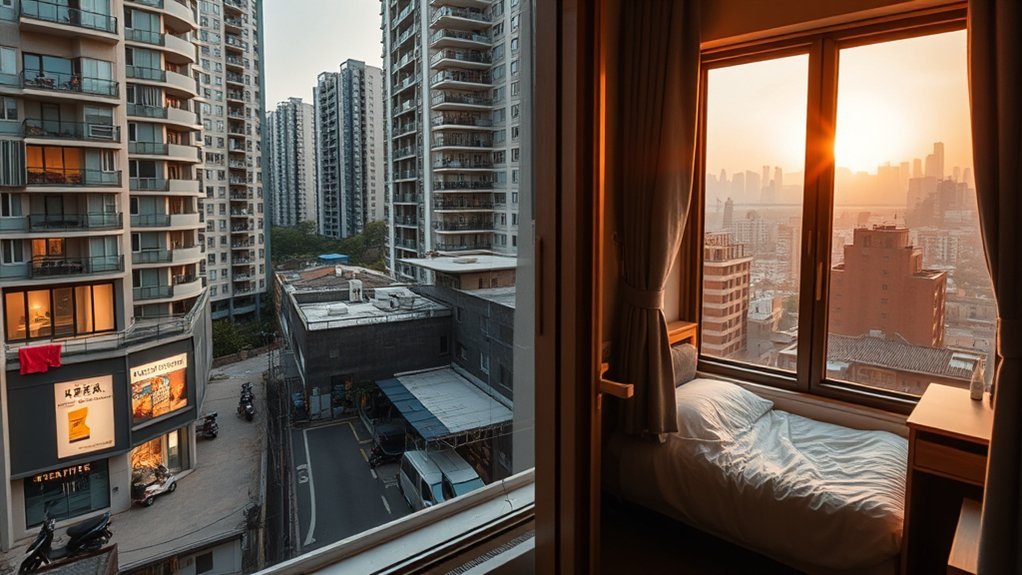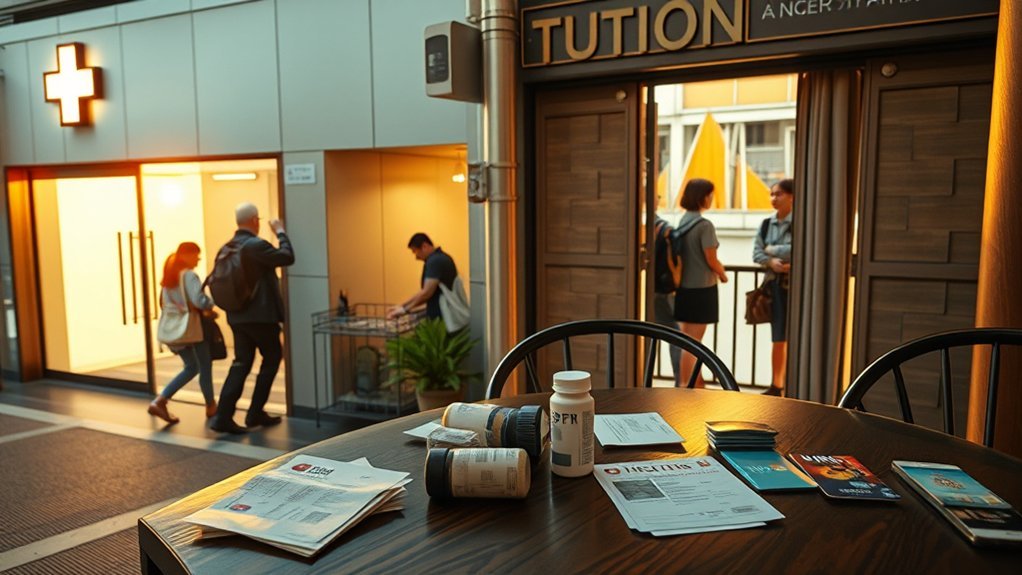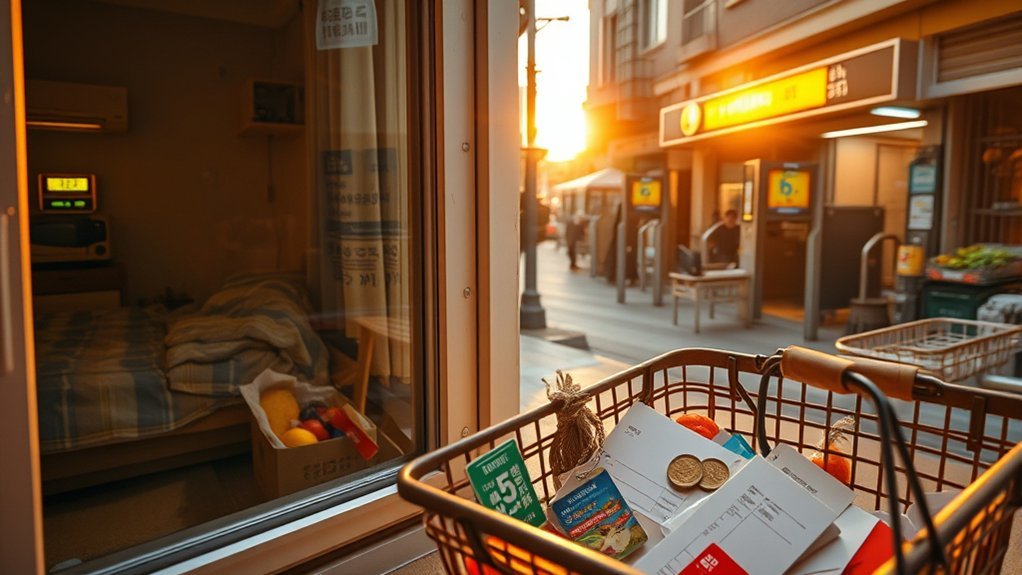You can expect basic monthly living costs in South Korea to range from about ₩652,000 if you’re single to ₩2,300,000 for a family of four, with rent being the biggest variable. Tiny rooms run $400–$600, officetels $600–$1,500, and utilities plus internet add roughly ₩100,000. Transport and food are affordable — subways ≈₩1,250 and casual meals ₩4,000–₩8,000 — and healthcare is partly covered by NHI; keep reading for detailed breakdowns.
Living Expenses and Monthly Budget Breakdown

While your exact monthly bill will depend on location and lifestyle, you can expect a single person’s non-rent living costs in South Korea to run about ₩652,000 (USD $470) per month, compared with roughly ₩2,300,000 (USD $1,650) for a family of four. You’ll use that average cost of living to plan monthly expenses: utilities average ₩100,000, with electricity often ₩10,000–₩30,000. Grocery prices stay reasonable—milk about ₩2,875, chicken fillets ₩12,075—but dining out pushes costs (cheap dinner for two ~₩20,000). Transportation costs are low: subway fares ~₩1,250 and taxi base ~₩3,500, so public transportation in South Korea is a budget-friendly pillar of mobility. Healthcare is affordable relative to many countries, reducing unexpected shocks to your budget. Housing expenses often take 30–40% of salary, so excluding rent lets you see true discretionary spending. Use these figures to reclaim financial freedom and structure a monthly budget that matches your goals.
Housing Options and Rental Costs

You’ll typically pay $400–$600/month for tiny rooms in Seoul and $600–$1,500 for modern officetels, with roughly $100/month extra for utilities and internet. South Korea’s lease models—large upfront deposit (jeonse) or smaller deposit with monthly rent (wolse)—can shift your cash-flow needs more than the listed monthly rates. Expect studios to be cheaper than officetels, and prices to spike near subway hubs and hot neighborhoods like Hongdae versus quieter areas like Sango or Noan.
Monthly Rent Ranges
Expect to pay roughly $400–$600 for tiny rooms in Seoul and $600–$1,500 for modern officetels, with actual costs hinging on neighborhood and transport access. You’ll compare rental prices across districts: Hongdae trends higher while Sango or Noan offer more affordable neighborhoods. For expats in South Korea, monthly rent decisions should weigh proximity to subway against unit size and amenities. Remember the market’s split model can lower monthly outlay but raise upfront commitment, affecting your ability to save or access the public healthcare system and whether you need private health insurance. Use data—price per square meter, commute time, and neighborhood trends—to choose housing that advances financial freedom and offsets the city’s high cost of living.
Deposit (Jeonse/Wolse)
Because rental costs hinge on contract type, you’ll choose between jeonse—large lump-sum deposits often equal to 50–80% of a property’s value—and wolse, which pairs a much smaller deposit (roughly ₩1M–₩10M / $750–$7,500) with monthly rent; jeonse deposits commonly run ₩100M–₩300M ($75,000–$225,000) in Seoul, so it’s a trade-off between tying up capital and lowering recurring expenses. You’ll weigh housing costs: jeonse frees you from monthly rent but locks capital; wolse preserves liquidity but raises monthly rent. Proximity to subway stations shifts value. Compare scenarios, calculate opportunity cost, and pick the rental system that matches your cash freedom and living experience.
| Option | Character |
|---|---|
| Jeonse | Large deposit, low monthly rent |
| Wolse | Small deposit, ongoing monthly rent |
| Transit | Close = higher cost, better living experience |
Studio vs. Officetel
While studios typically run $400–$600/month (utilities included) and officetels sit at $600–$1,500, the choice hinges on space, amenities, and rental structure: studios are cheaper base options but often lack the built-in amenities and flexibility of officetels, which combine residential and commercial use and can command higher rents—especially near subway hubs like Hongdae. You’ll weigh lower rental prices of a studio apartment against officetel benefits: better security, on-site facilities, and resale/rental flexibility. Factor key money patterns—large deposits can reduce monthly rent but tie up capital—and monthly utility costs (around $100) into total living expenses. For expats seeking autonomy, compare proximity to subway stations, long-term cash flow, and lifestyle to choose the fit.
Utilities, Internet, and Mobile Expenses

If you break down monthly household running costs in South Korea, utilities—electricity, gas, and water—typically add about ₩100,000 (~$84) depending on usage and household size, with electricity usually ₩10,000–₩30,000, gas ₩10,000–₩100,000, and water around ₩10,000 (often included in rent); add internet/TV at ₩30,000–₩50,000 and mobile plans from about ₩30,000 for unlimited data to estimate a combined utilities and connectivity bill. You’ll find that average monthly utilities and connectivity are affordable relative to typical monthly salary ranges, especially if you share costs. Electricity and gas swing with season and habits, so compare seasonal bills when budgeting. Internet is reliable and competitively priced, making remote work and study accessible. Mobile expenses start low for unlimited plans, so you can pick a plan that fits usage without breaking your budget. If you aim for financial freedom while living in South Korea, controlling utilities and choosing the right internet and mobile package will boost monthly savings.
Food, Groceries, and Dining Out

After you’ve managed utilities and connectivity, your next big monthly variable is food — both groceries and eating out — which can swing widely depending on choices and habits. You’ll find street food at ₩1,000–₩3,000 ($1–$3) per item, letting you eat cheaply and move freely. Casual restaurants serving gimbap or bibimbap run about ₩4,000–₩8,000 ($4–$7), a reliable budget-friendly daily option. Dining out at Korean barbecue is pricier: ₩15,000–₩30,000 ($12–$25) per person, with some unlimited plans from ₩20,000 ($17). Groceries are reasonable — milk ≈ ₩2,875 ($2.50), chicken fillets ≈ ₩12,075/kg ($10.50) — so cooking cuts costs if you value autonomy. Convenience-store meals span ₩1,000–₩7,000 ($1–$6). Western dishes often cost more, ₩12,000–₩35,000 ($10–$30). Track meal prices against your income and lifestyle: prioritize groceries and street food to maximize freedom, reserve restaurants for social or cultural treats.
Transportation, Driving, and Commuting Costs

You’ll find public transit in cities is inexpensive — subway trips run about 2,300 KRW (≈2 USD) and buses 1,000–2,400 KRW (0.85–2 USD), with a T-money card easing transfers and small purchases. If you plan to drive, rentals generally require you to be at least 21 with an international license and you must follow strict rules like a 0.03% BAC limit. For longer trips, taxis can jump from a 3,500 KRW (≈3 USD) base fare to as much as 24,000 KRW (≈20 USD), so compare costs between intercity trains/buses and taxis.
Public Transit Fares
While public transit in South Korea stays affordable, costs vary by mode and distance: city subway rides run about 1,250 KRW (~$1) per trip, buses cost 1,000–2,400 KRW ($0.85–$2) with night fares at 2,400 KRW, and taxis start around 3,500 KRW ($3) by day and 4,600 KRW ($4) at night plus distance charges. You’ll find subway rides are the affordable option for daily commuting, especially if you tap a T-money transportation card (about 4,000 KRW) for seamless transfers across public transport systems and small purchases. Taxi fares are practical for short, late trips but add up compared with buses. For intercity travel, long-distance buses range 17,860–60,000 KRW one way; KTX to Busan costs ~50,000 KRW.
Driving and Licensing
If you prefer driving over Seoul’s efficient subway and bus networks, know that traffic moves on the right and you must be at least 18 to drive a car in South Korea. You’ll weigh freedom versus convenience: public transportation with subway fares ~₩1,250 and transportation cards is cheaper and seamless; driving gives control but has rules. International driving permits are required with your original license and valid one year; renting a car needs minimum age 21 plus permit or Korean license. Taxi fares start ~₩3,500 day, ₩4,600 night — a middle ground for quick escape. Compare costs, safety, and autonomy before committing: choose the mode that liberates your schedule and wallet.
| Option | Cost (approx) | Freedom |
|---|---|---|
| Subway | ₩1,250 | Low |
| Taxi | ₩3,500–4,600 | Medium |
| Renting | Variable | High |
Long-Distance Travel Costs
Because long-distance options vary widely by speed and cost, plan trips with price and time in mind: one-way intercity fares range roughly ₩17,860–₩60,000 (US$15–50) depending on distance and transport mode, city subways average about ₩2,300 (US$2) per ride, and taxis start at ₩3,500–₩4,600 (US$3–4) but can climb to ₩24,000 (US$20) for longer trips; renting a car (minimum age 21, valid license + IDP or Korean license) adds insurance and fuel costs and usually ends up pricier than public transit, while a ₩4,000 (US$3.50) transportation card makes transfers across buses, subways and some trains most cost-effective. You’ll find public transportation efficient, letting you minimize living expenses by favoring subway rides and buses. Compare one-way ticket prices, factor taxi base fare for late or emergency trips, and use transportation cards to control costs.
Healthcare, Education, and Insurance

Though public services cover the basics, you’ll pay considerably more for private options: South Korea’s National Health Insurance (NHI) covers 50–80% of medical costs; premiums average 120,000 KRW/month (~$100). Regular outpatient visits run 10,000–30,000 KRW (~$7–$21), so basic healthcare stays affordable, but you may choose private health insurance (~114,000 KRW/month) to reduce out-of-pocket risk. Public education is free, yet language barriers push many expat families toward international schools; tuition averages 24,000,000 KRW/year (~$20,100), a major living expenses line. Compare public vs private: public offers stability and lower cost; private buys speed, language fit, and perceived advantage. If you seek liberation from uncertainty, quantify trade-offs: add private health insurance for financial predictability or invest in international schooling for your children’s mobility. Decide which costs you tolerate and which you’ll pay to expand choice and freedom.
| Cost item | Emotional weight |
|---|---|
| NHI premiums | Relief |
| Private insurance | Security |
| Public school | Stability |
| International schools | Aspiration |
Frequently Asked Questions
How Much Money Do You Need to Live Comfortably in South Korea?
You’ll need about ₩2.5–3.5M monthly for comfortable living; cost breakdown shows monthly expenses vary by lifestyle choices — food prices, transportation costs, entertainment budget, healthcare expenses affect savings potential, so compare cities.
How Much Is the Average House Rent in South Korea?
Coincidentally, house rent averages ₩400,000–₩600,000 monthly, but Seoul spikes higher. You’ll compare city comparison, suburbs living, housing types, rental contracts, cost variations, utilities included, and neighborhood factors to choose freedom through data-driven choice.
Can I Live Permanently in South Korea?
Yes—you can live permanently in South Korea: permanent residency options exist. Compare visa requirements overview, job market insights, healthcare system navigation; anticipate language barriers challenges, lifestyle adjustments needed, use cultural integration tips and expat community support.
Is It Cheaper to Live in South Korea or the USA?
Yes — South Korea’s cheaper overall: cost comparison shows lower living expenses, housing market, food prices, transportation costs, and healthcare services, though lifestyle differences and quality of life vary; you’ll weigh data, freedom, and choices.
Conclusion
You’ll find South Korea can fit many budgets, but expect trade-offs: Seoul’s one-bedroom rentals average $900–1,200, while smaller cities drop to $400–700. Utilities, transit, and groceries often add $300–500 monthly; private health insurance and tuition vary widely. Imagine Mina, an English teacher in Busan, who saves 30% of her $2,200 salary by choosing a studio and cooking at home—showing measured choices let you balance quality of life with clear costs.


